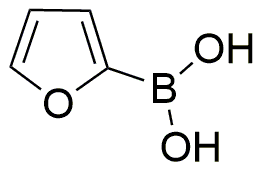2-Furylboronic acid is widely utilized in research focused on:
- Organic Synthesis: This compound serves as a versatile building block in the synthesis of various organic molecules, particularly in the development of pharmaceuticals and agrochemicals.
- Cross-Coupling Reactions: It is commonly used in Suzuki-Miyaura coupling reactions, which are essential for forming carbon-carbon bonds, making it valuable in the production of complex organic compounds.
- Sensor Development: 2-Furylboronic acid is employed in the creation of chemical sensors for detecting glucose and other biomolecules, enhancing diagnostics in the medical field.
- Polymer Chemistry: This compound can be incorporated into polymer matrices, improving material properties for applications in coatings and adhesives.
- Research in Catalysis: It plays a role in catalytic processes, contributing to more efficient and sustainable chemical reactions in various industrial applications.
General Information
Properties
Safety and Regulations
Applications
2-Furylboronic acid is widely utilized in research focused on:
- Organic Synthesis: This compound serves as a versatile building block in the synthesis of various organic molecules, particularly in the development of pharmaceuticals and agrochemicals.
- Cross-Coupling Reactions: It is commonly used in Suzuki-Miyaura coupling reactions, which are essential for forming carbon-carbon bonds, making it valuable in the production of complex organic compounds.
- Sensor Development: 2-Furylboronic acid is employed in the creation of chemical sensors for detecting glucose and other biomolecules, enhancing diagnostics in the medical field.
- Polymer Chemistry: This compound can be incorporated into polymer matrices, improving material properties for applications in coatings and adhesives.
- Research in Catalysis: It plays a role in catalytic processes, contributing to more efficient and sustainable chemical reactions in various industrial applications.
Documents
Safety Data Sheets (SDS)
The SDS provides comprehensive safety information on handling, storage, and disposal of the product.
Product Specification (PS)
The PS provides a comprehensive breakdown of the product’s properties, including chemical composition, physical state, purity, and storage requirements. It also details acceptable quality ranges and the product's intended applications.
Certificates of Analysis (COA)
Search for Certificates of Analysis (COA) by entering the products Lot Number. Lot and Batch Numbers can be found on a product’s label following the words ‘Lot’ or ‘Batch’.
*Catalog Number
*Lot Number
Certificates Of Origin (COO)
This COO confirms the country where the product was manufactured, and also details the materials and components used in it and whether it is derived from natural, synthetic, or other specific sources. This certificate may be required for customs, trade, and regulatory compliance.
*Catalog Number
*Lot Number
Safety Data Sheets (SDS)
The SDS provides comprehensive safety information on handling, storage, and disposal of the product.
DownloadProduct Specification (PS)
The PS provides a comprehensive breakdown of the product’s properties, including chemical composition, physical state, purity, and storage requirements. It also details acceptable quality ranges and the product's intended applications.
DownloadCertificates of Analysis (COA)
Search for Certificates of Analysis (COA) by entering the products Lot Number. Lot and Batch Numbers can be found on a product’s label following the words ‘Lot’ or ‘Batch’.
*Catalog Number
*Lot Number
Certificates Of Origin (COO)
This COO confirms the country where the product was manufactured, and also details the materials and components used in it and whether it is derived from natural, synthetic, or other specific sources. This certificate may be required for customs, trade, and regulatory compliance.


